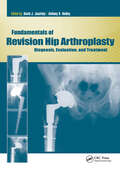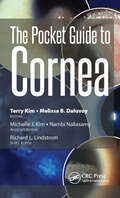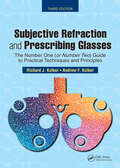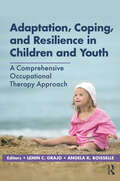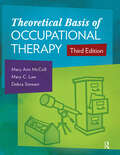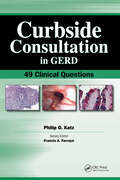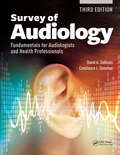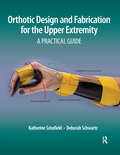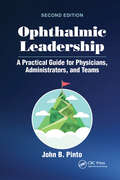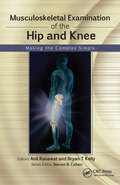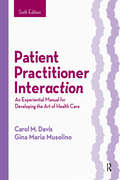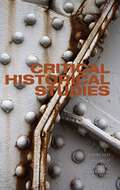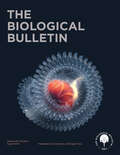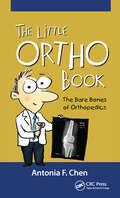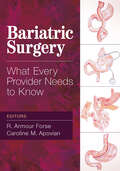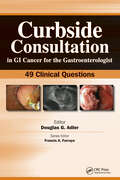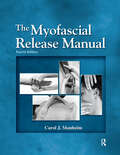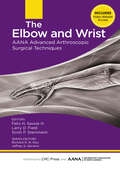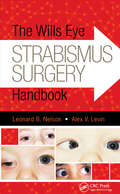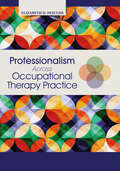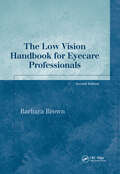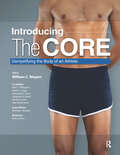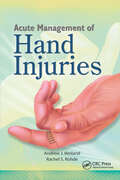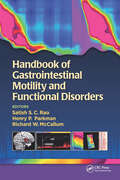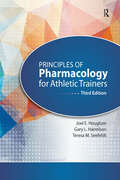- Table View
- List View
Fundamentals of Revision Hip Arthroplasty: Diagnosis, Evaluation, and Treatment
by David Jacofsky Anthony HedleyFundamentals of Revision Hip Arthroplasty: Diagnosis, Evaluation, and Treatment is a unique and very timely book designed for surgeons who are beginning to more commonly encounter hip revisions in their practice. Unlike many traditional books on revision, Fundamentals of Revision Hip Arthroplasty does not focus on the most difficult and challenging of cases. Rather, Fundamentals of Revision Hip Arthroplasty is intended to guide the surgeon in the evaluation of the failed or painful total joint replacement, review basic tenants and surgical principles of revision arthroplasty, and guide the surgeon in determining whether a given case is one that should be managed or is best referred to a tertiary orthopedic center.Along with their 32 contributors, Dr. David J. Jacofsky and Dr. Anthony K. Hedley provide detailed information inside Fundamentals of Revision Hip Arthroplasty, including appropriate preoperative evaluation, equipment requirements, surgical planning, need for augments and allograft, and surgical techniques.Surgeons will be tackling hip revision surgery more frequently as the number of these cases is exponentially increasing. Fundamentals of Revision Hip Arthroplasty provides a “go-to” resource to turn to for guidance by community arthroplasty surgeons, arthroplasty fellows, and residents.
The Pocket Guide to Cornea (Pocket Guides)
by Terry Kim Melissa DaluvoyAre you a medical student or resident trying to absorb as much information on the cornea as efficiently as possible? Are you an ophthalmologist who needs fast facts on a specific corneal disease? Reach into your lab coat pocket and pull out The Pocket Guide to Cornea for easy access to the information you need right now. Drs. Terry Kim and Melissa Daluvoy have designed this book as the most effective way to take in the information on the cornea for the entire spectrum of eye care providers. Medical students and residents will be pleased to have this accessible, high-yield handbook during their rotations to familiarize themselves with cornea findings and diagnoses, while seasoned ophthalmologists will be glad to have it as a refresher or quick reference guide to current diagnostic and treatment standards. Contained within The Pocket Guide to Cornea is the most essential information on the cornea organized in the most efficient ways. Each chapter is arranged in bullet-point style, for quick access to the relevant information, and is accompanied by numerous color photographs to help with recognition and retention.Topics covered: Basic examination techniques Anterior segment testing and imaging Common to rare cornea diseases Common procedures and surgeries The entire spectrum of eye care providers can benefit from the high-yield, quick-access information contained within The Pocket Guide to Cornea, whether they are learning about the cornea for the first time or they just need a quick refresher on an obscure corneal disease.
Subjective Refraction and Prescribing Glasses: The Number One (or Number Two) Guide to Practical Techniques and Principles, Third Edition
by Richard KolkerBasic refraction is a foundational part of ophthalmology, and yet beginning ophthalmology residents and ophthalmic technicians are often left on their own to learn the finer points. Despite being core skills, the techniques and practical aspects of subjective refraction and prescribing glasses are often developed by trial and error, if they are developed at all.Subjective Refraction and Prescribing Glasses: The Number One (or Number Two) Guide to Practical Techniques and Principles, Third Edition is designed as a complete guide to those essential skills, offering everything from basic terminology to tips, tricks, and best practices. This updated Third Edition has been expanded in every section with thoughtful, practical advice, and has case scenarios, in a question and answer format, of situations encountered with real-world patients. It is the most comprehensive review of clinical subjective refraction to date. Drs. Richard Kolker and Andrew Kolker together have nearly 50 years of experience in the practice of ophthalmology and bring both the fresh eyes of a beginning ophthalmologist and the experience of a seasoned veteran to this Third Edition. While new residents and technicians will appreciate the thorough explanation of refractive fundamentals, even expert ophthalmologists will appreciate the practical tips that may have never occurred to them. Included are: Very clear, easy-to-read, practical explanations of the subjective refraction process Basic practical optics to explain the steps of subjective refraction The Jackson Cross Cylinder made easy to understand and use Plus and mInus cylinder methods discussed separately and color coded for quick identification An Appendix with a primer on retinoscopy and how to use the manual lensometer The art of subjective refraction and prescribing glasses Subjective Refraction and Prescribing Glasses: The Number One (or Number Two) Guide to Practical Techniques and Principles, Third Edition is the definitive guide to the often neglected skills involved in clinical subjective refraction. Residents and technicians will find it a critical guide in their learning process, but even seasoned ophthalmologists can benefit from the tips and tricks enclosed within.
Adaptation, Coping, and Resilience in Children and Youth: A Comprehensive Occupational Therapy Approach
by Lenin Grajo Angela BoisselleA groundbreaking text for occupational therapists, Adaptation, Coping, and Resilience in Children and Youth: A Comprehensive Occupational Therapy Approach offers a different perspective in addressing the ways children and youth with a variety of conditions and personal contexts can have more optimized participation in everyday life. This text is essential for occupational therapy graduate students, instructors, and pediatric clinicians.Drs. Lenin C. Grajo and Angela K. Boisselle provide a comprehensive, strength-based approach in addressing the ability of children to adjust to a variety of challenges encountered in daily life across multiple environments and contexts. Adaptation, Coping, and Resilience in Children and Youth includes best and evidence-based practices for assessment and intervention.Included in the book: Collaborative approach with families How to build relationships through interprofessional collaboration (teachers, health care team, and community) Global perspectives of adaptation, coping, and resilience Case applications and essential considerations for occupational therapists The text also covers underexplored contexts such as those who have been bullied, children and youth who are LGBTQ and gender expansive, children and youth of color, those who live as a member of a migrant family, and those who have lived with and through adverse childhood experiences.Adaptation, Coping, and Resilience in Children and Youth: A Comprehensive Occupational Therapy Approach is a necessary text that offers timely best and evidence-based practices for assessment and intervention for occupational therapy students and professionals.
Theoretical Basis of Occupational Therapy
by Mary Ann McColl Mary C. Law Stewart DebraTheoretical Basis of Occupational Therapy, Third Edition shows the results of an exhaustive review of international peer-reviewed literature in occupational therapy and provides a synthesis of current theoretical developments in occupational therapy and occupational science. This helps occupational therapy students, researchers, and clinicians understand how to think about occupation, the many factors that affect occupation, and how to use occupation therapeutically to promote health and well-being. Unlike earlier editions, this updated Third Edition debuts during a time when even casual searchers can readily find huge amounts of information on the internet with the click of a search button. To remain relevant, this Third Edition goes beyond simply providing an annotated bibliography of peer-reviewed literature by also giving readers an analysis and synthesis of these documents in a clear and compelling organizational structure. Led by Mary Ann McColl, Mary Law, and Debra Stewart, Theoretical Basis of Occupational Therapy, Third Edition also offers an appendix that catalogs the literature included. In each of the determinants of occupation chapters, the contributors have extracted key themes, followed threads of theoretical development, reflected on external influences of occupational therapy theory, and commented particularly on developments over the last 15 years. New Features of the Third Edition: An updated database of articles A look at both determinants and consequences of occupation Further development of the three metaphors (the filing cabinet, toolbox, and telescope) that help organize and retrieve occupational therapy theory New contributing authors to supplement content New sections about the major named occupational therapy models Theoretical Basis of Occupational Therapy, Third Edition offers a classification system for theory, a digest of new developments in each area of the classification system, and a commentary on theoretical developments across theory areas that advance the knowledge and expertise of the profession as a whole.
Curbside Consultation in GERD: 49 Clinical Questions (Curbside Consultation in Gastroenterology)
by Philip O. KatzAre you looking for concise, practical answers to questions that are often left unanswered by traditional GERD references? Are you seeking brief, evidence-based advice for complicated cases or complications? Curbside Consultation in GERD: 49 Clinical Questions provides quick and direct answers to the thorny questions commonly posed during a “curbside consultation” between colleagues.Dr. Philip Katz has designed this unique reference, which offers expert advice, preferences, and opinions on tough clinical questions commonly associated with GERD. The unique Q&A format provides quick access to current information related to GERD with the simplicity of a conversation between two colleagues. Numerous images, diagrams, and references are included to enhance the text and to illustrate the treatment of GERD patients.Curbside Consultation in GERD: 49 Clinical Questions provides information basic enough for residents while also incorporating expert advice that even high-volume clinicians will appreciate. Gastroenterologists, fellows and residents in training, surgical attendings, and surgical residents will benefit from the user-friendly and casual format and the expert advice contained within.Some of the questions that are answered: Can medical therapy alter the natural history of Barrett’s esophagus? Can antireflux surgery alter the natural history of Barrett’s esophagus? How does pregnancy affect GERD? Is GERD in pregnancy a risk for long-term reflux? What is the association of obesity and GERD? What are the so-called extraesophageal manifestations of GERD? Is there a gender difference in reflux disease? Does this affect treatment?
Survey of Audiology: Fundamentals for Audiologists and Health Professionals, Third Edition
by David DeBonis Constance DonohueFor nearly 20 years, Survey of Audiology: Fundamentals for Audiologists and Health Professionals has provided both the breadth of an introductory survey of audiology and the depth of a detailed textbook. Inside, Drs. David DeBonis and Constance Donohue have combined their years of work in clinical settings and their experience teaching audiology into a textbook intended to give students all the knowledge they’ll need in the most accessible and comprehensible format.In this Third Edition, updates have been made to include the latest information on the most current topics in audiology, including cognition and hearing loss, pharmacology, central auditory processing disorders, wireless technology, hearing aid accessibility, tinnitus, genetics and biotechnology, and noise exposure.New and updated inside the Third Edition: Ethical considerations for audiologists Auditory Neuropathy Spectrum Disorder (ANSD) Auditory processing disorders Tinnitus Evidence-based genetic counseling The latest hearing aid technology How to critically review evidence in literature and studies Included with the text are online supplemental materials for faculty use in the classroom.With its extensive glossary, numerous case examples, chapter abstracts, learning objectives, and questions for discussion, Survey of Audiology is designed to support learning and reinforce key points in every way. The text also works to integrate the humanistic aspects of audiology with the scientific ones into holistic discussions of assessment and intervention. Through this approach, students will learn to always remember that there is a person behind each set of symptoms.While aspiring audiologists will appreciate the depth of Survey of Audiology: Fundamentals for Audiologists and Health Professionals, Third Edition, students of speech-language pathology and other health professions looking for a crash course in audiology will benefit from its readability and wide scope.
Orthotic Design and Fabrication for the Upper Extremity: A Practical Guide
by Katherine Schofield Deborah SchwartzOrthotic Design and Fabrication for the Upper Extremity: A Practical Guide by Drs. Katherine Schofield and Deborah Schwartz is a unique guide that illustrates orthotic design and fabrication in a clear step-by-step fashion by presenting printed textual material along with instructional videos. The first chapters lay the foundation for orthotic design and detail the anatomical knowledge and background information that is required before molding orthoses on clients. Each chapter explores a specific part of the upper extremity, describes several common clinical diagnoses, and highlights typical orthoses that might be utilized to immobilize and protect it. Together, these chapters communicate core, foundational knowledge for the use of orthoses as an intervention in occupational therapy practice. The instructional videos also emphasize the application of biomechanical, anatomic, and clinical constructs in orthotic design, fabrication, and evaluation. The textbook and video content work together enabling students and entry-level practitioners to learn with visual and versatile resources. University faculty members will gain access to ample activities and exercises to augment their classroom and laboratory teaching. This allows for more efficient use of time and appeals to the learning styles of current and future students. This text includes: Chapters devoted to specific type of orthosis for parts of the upper extremity linked to step -by -step instructional videos Case studies to promote a grasp of the knowledge and application to the development of clinical reasoning skills Multiple choice and short answer review questions and activities for most chapters Presentation of current evidence to support the use of the specific orthoses in clinical practice Patterns that can be replicated and check out sheets to critique each orthosis The combination of text materials and instructional video material makes Orthotic Design and Fabrication for the Upper Extremity: A Practical Guide a uniquely valuable resource for occupational therapy students, new graduates, and novice clinicians.
Ophthalmic Leadership: A Practical Guide for Physicians, Administrators, and Teams
by John B. PintoOphthalmic practices have many types of leaders, functioning at all levels of the organization. Ophthalmic Leadership: A Practical Guide for Physicians, Administrators, and Teams, Second Edition can provide each of these leaders with the tools to be more decisive, motivating, and effective.John B. Pinto, America’s most published author on the business of ophthalmology, has firsthand experience with the best and worst practice leadership habits from his decades of experience as an ophthalmic practice consultant. He has coached countless physician and lay leaders to the next level of their careers. Together with his team of more than 20 expert contributors, Pinto covers every aspect of leadership in ophthalmology, no matter the size of the practice or the current experience of the team.Chapters include: What Do You Believe in? Developing a List of Core Values for Your Practice Grooming and Moving Line Staff Up to Middle Management Contingency Planning in a Less-Certain Environment Leading Your Team Past the Inevitable Conflicts of Practice Life Everyone in ophthalmology can benefit from the lessons inside Ophthalmic Leadership: A Practical Guide for Physicians, Administrators, and Teams, Second Edition—from the rising ophthalmic technician or department manager, to the managing partner, and even the most seasoned practice administrator.“The book you now hold is a wonderful opportunity to rededicate yourself to your professional development as a leader and to the success of your organization.”From the Foreword by Richard L. Lindstrom, MD
Musculoskeletal Examination of the Hip and Knee: Making the Complex Simple
by Bryan Kelly Anil RanawatThe physical examination of the hip and knee can be a complex topic for professionals with all levels of clinical experience. How can advance concepts be taught in a user-friendly, clear format, while still providing necessary information for effective diagnosis and treatment of the hip and knee?Musculoskeletal Examination of the Hip and Knee: Making the Complex Simple by Drs. Anil Ranawat and Bryan T. Kelly answers these questions. Written by experts, this easy-to-carry book provides a thorough review of the most common pathologic hip and knee conditions, techniques for diagnosis, as well as the appropriate treatment for each condition.Musculoskeletal Examination of the Hip and Knee: Making the Complex Simple contains clear photographic demonstrations, tables, and charts throughout its pages, allowing a thorough and concise examination of the hip and knee.A glance at some of what is covered inside: Physical Examination Basics and specific tests of the physical examination of the hip and knee General Imaging Basics of general imaging of the hip and knee Common Conditions Arthroscopic management of labral tears, snapping hip syndromes, meniscal tears, and more Musculoskeletal Examination of the Hip and Knee: Making the Complex Simple contains essential information to successfully take a complex subject and bring it to a level that will be welcomed by orthopedic residents, attendings, physical therapists, athletic trainers, medical students in training, and other health care providers.
Patient Practitioner Interaction: An Experiential Manual for Developing the Art of Health Care
by Carol M. Davis Gina Maria MusolinoFor over 20 years, Patient Practitioner Interaction: An Experiential Manual for Developing the Art of Health Care has been the cornerstone textbook for health care professionals to learn and develop effective interpersonal professional behavior. Building on the foundational knowledge of past editions, the updated Sixth Edition continues to teach health care professionals how to develop self-awareness and communication skills critical to providing ethical, compassionate, and professional treatment and care for and with their patients. Drs. Carol M. Davis and Gina Maria Musolino designed the textbook to assist both faculty and students through instructional and learning objectives emphasizing the importance of self-awareness in patient interaction. The Sixth Edition guides faculty in teaching the essential component required of all health care professionals: the ability to know oneself and one’s patterns of response in highly contentious situations. Through the featured learning activities and chapters on self-awareness and self-assessment, students will be able to better understand, change, and evaluate their learned patterns, values, and readiness for mature patient interactions for both typical and challenging patient care situations. The learned skills of self-awareness and effective interpersonal communication allow clinicians, faculty, and students to provide compassionate and therapeutic treatment and care for the good of the patients and their families. Developing health care providers are also guided in new focus areas in health care leadership and advocacy through interactive exercises. Features and benefits of the Sixth Edition: Four chapters on self-awareness to guide students in evaluating their values and readiness for mature interaction with patients under stressful situations, as well as their ability and capability for self-assessment and peer-assessment Interactive and online learning activities of real-life clinical situations and vignettes with tools provided to use in the classroom to make learning active and engaging. New content areas addressing leadership and advocacy with professional and community organizations; and self and peer assessment for fostering reflective professional development. An accompanying Instructor’s Manual to help faculty learn how to convey the material in effective ways Included with the text are online supplemental materials for faculty use in the classroom. Patient Practitioner Interaction: An Experiential Manual for Developing the Art of Health Care, Sixth Edition will continue to be the go-to resource for students, faculty, and clinicians in allied health professions for effective patient interaction.
Critical Historical Studies, volume 11 number 1 (Spring 2024)
by Critical Historical StudiesThis is volume 11 issue 1 of Critical Historical Studies. Critical Historical Studies is an interdisciplinary journal devoted to historical reflections on politics, culture, economy, and social life. CHS features research on the implications of socio-economic transformations for cultural, political, and social change. In the broad tradition of Critical Theory, CHS will explore the complex connections between cultural form and socio-economic context and promote a reflexive awareness of the researcher’s own position in the history of global capitalist society. The journal aims to foster interdisciplinary exchange among scholars across the entire range of the social sciences and humanities, and publishes work on all historical eras and regions of the world.
The Biological Bulletin, volume 245 number 1 (August 2023)
by The Biological BulletinThis is volume 245 issue 1 of The Biological Bulletin. The Biological Bulletin disseminates novel scientific results in broadly related fields of biology in keeping with more than 100 years of a tradition of excellence. The Bulletin publishes outstanding original research with an overarching goal of explaining how organisms develop, function, and evolve in their natural environments. To that end, the journal publishes papers in the fields of Neurobiology and Behavior, Physiology and Biomechanics, Ecology and Evolution, Development and Reproduction, Cell Biology, Symbiosis and Systematics. The Bulletin emphasizes basic research, including articles on marine model systems and those of an interdisciplinary nature.
The Little Ortho Book: The Bare Bones of Orthopedics
by Antonia ChenThe Little Ortho Book: The Bare Bones of Orthopedics is a pocket-sized, easy-to-understand introduction into the field of orthopedics. Written with the non-physician in mind, The Little Ortho Book provides the basics of orthopedics for residents, medical students, front office staff, and industry sales force. Dr. Antonia Chen takes complicated orthopedic terms and conditions and explains them in ways that are understandable to all. By focusing on common orthopedic diagnoses and relevant anatomy, The Little Ortho Book: The Bare Bones of Orthopedics answers the questions that arise from orthopedic conditions in user-friendly language that is understandable to everyone. Portable and handy and supplemented with images and diagrams, this conversational-style book packs a big punch!What is Inside:• Descriptions of joint biomechanics and bone and muscle composition• Commonly performed exams are explained with a description of the condition being tested• Sports injuries, fractures, arthritis, and orthopedic conditions in children • Description of medications that are commonly prescribed in orthopedics• Commonly performed orthopedic surgeries, including indications for surgery and descriptions of the procedures performed – all described in simplistic detailThe Little Ortho Book: The Bare Bones of Orthopedics is an easy-to-read resource for a wide variety of audiences who work in the orthopedic industry or with orthopedic patients, but isn’t an orthopedic surgeon.
Bariatric Surgery: What Every Provider Needs to Know
by Caroline Apovian R. Armour ForseWith obesity levels continuing to rise despite efforts in diet, exercise, and medical management, the focus has now turned to surgery to help combat the obesity epidemic. The operation is just the beginning, and there can be many different complications and side effects associated with weight loss surgery. Bariatric Surgery: What Every Provider Needs to Know takes a multidisciplinary team approach to maximize the patient’s weight loss and to minimize complications, from patient selection to postoperative care. This book was written for any healthcare providers or students involved with bariatric surgical patients to provide them with the important information needed to manage their patient. Drs. R. Armour Forse and Caroline M. Apovian and more than 50 contributors have designed Bariatric Surgery: What Every Provider Needs to Know to provide practical information for non-surgeons and non-nutrition experts who are involved in the care of a patient undergoing bariatric surgery and makes the concepts easy to understand and to apply when caring for a patient with obesity.Bariatric Surgery: What Every Provider Needs to Know covers the fundamental issues that need to be addressed with the overall care of the surgical patient for a multidisciplinary team, including nurse practitioners, physician assistants, gastroenterology residents, dieticians, and medical students. Some topics covered include: Adolescent obesity and weight loss surgery Various surgical procedures such as gastric banding, sleeve gastrectomy, and gastric bypass Anesthetic issues in the patient with obesity undergoing surgery Bariatric surgery and the elderly Immediate postoperative complications Medical management of the patient after bariatric surgery Psychological issues in the bariatric surgery patient
Curbside Consultation in GI Cancer for the Gastroenterologist: 49 Clinical Questions (Curbside Consultation in Gastroenterology)
by Douglas AdlerAre you looking for concise, practical answers to questions that are often left unanswered by traditional cancer references that are not designed for gastroenterologists? Are you seeking brief, evidence-based advice for complicated cases or patients with complications that need management? Curbside Consultation in GI Cancer for the Gastroenterologist: 49 Clinical Questions provides quick and direct answers to the thorny questions commonly posed during a “curbside consultation” between colleagues.Dr. Douglas G. Adler has designed this unique reference, which offers expert advice, preferences, and opinions on tough clinical questions commonly associated with GI cancer. The unique Q&A format provides quick access to current information related to GI cancer with the simplicity of a conversation between two colleagues. Numerous images, diagrams, and references are included to enhance the text and to illustrate the treatment of GI cancer patients.Curbside Consultation in GI Cancer for the Gastroenterologist: 49 Clinical Questions provides information basic enough for residents while also incorporating expert advice that even high-volume clinicians will appreciate. Gastroenterologists, fellows and residents in training, surgical attendings, and surgical residents will benefit from the user-friendly and casual format and the expert advice contained within.Some of the questions that are answered:• An 81-year-old man is found to have unresectable esophageal cancer and malignant dysphagia. Should he have a stent? A nasogastric feeding tube? A PEG tube?• How is tumor-related bleeding from gastric cancers best approached?• Do patients with pancreatic cancer and jaundice need to have an ERCP preoperatively?• What is the role of ERCP and EUS in patients with suspected cholangiocarcinoma?• Why are rectal cancers so different from colon cancers with regards to medical and surgical management?Curbside Consultation in GI Cancer for the Gastroenterologist: 49 Clinical Questions illustrates how patients at different points in their treatment may go back and forth between specialists to receive coordination of care, and incorporates input from gastroenterologists, surgeons, radiologists, and oncologists. While providing up-to-date information, this book will help gastroenterologists to manage complex cancer-related issues and guide physicians through the maze of cancer-related treatments available.Ideal for practicing gastroenterologists, gastroenterology fellows, surgeons, oncologists, residents, and medical students, Curbside Consultation in GI Cancer for the Gastroenterologist: 49 Clinical Questions is sure to benefit anyone caring for patients with gastrointestinal cancers.
The Myofascial Release Manual
by Carol ManheimContinuing the tradition that started over 20 years ago and with a new focus on the current terminology regarding each technique, The Myofascial Release Manual is now available in a completely updated and comprehensive Fourth Edition.Carol J. Manheim has taken years of knowledge and expertise and incorporated them with the actual intent and result of the myofascial release treatment techniques to bring to the pages of this Fourth Edition essential information for the student and clinician in search of basic information or wanting to refine more experienced skills of these manual therapy techniques. Features inside the Fourth Edition: -Techniques re-titled to reflect the sensation felt by both the therapist and the patient -More than 75 new photographs—Over 450 in total -Some photographs are shown as a series to allow for movement to be seen during some techniques -Bolded text to call attention to major warnings, contraindications, and target vital information -Italicized text to call attention to important words and key points -More synthesized use of text and photographs to allow for ease of reading and reference -User-friendly organization throughout the text -Photographs use arrows to show direction of stretch and movement -“Carol’s Nuggets” of pearls of wisdom are included throughout the text -Contributions from renowned experts Sam Kegerreis, Robert O. Ward, and Steven Nowicki The Myofascial Release Manual, Fourth Edition continues in the tradition of past editions and presents expert hand placement for the upper quarter, lower quarter, cervical region, abdominal muscles, back muscles, and many more. Sections include: -Introduction to Myofascial Release -Basic Myofascial Release Techniques -Advanced Myofascial Release Techniques -Evaluation -Additional Resources The description and photographs in The Myofascial Release Manual, Fourth Edition help the therapist experience the technique, making this the continued go-to reference for students and clinicians in physical therapy, manual therapy, and occupational therapy alike.
The Elbow and Wrist: AANA Advanced Arthroscopic Surgical Techniques (AANA Advanced Arthroscopic Techniques series)
by Felix Savoie Larry Field Scott SteinmannCo-published with the Arthroscopy Association of North America, The Elbow and Wrist: AANA Advanced Arthroscopic Surgical Techniques is a comprehensive technique-based book that presents the latest diagnostic and reconstructive techniques in arthroscopic surgery for the elbow and wrist.The Elbow and Wrist: AANA Advanced Arthroscopic Surgical Techniques is authored by premier arthroscopic surgeons Drs. Felix H. Savoie III, Larry D. Field, Scott P. Steinmann, and their international list of expert contributors. This comprehensive resource includes preferred physical examination testing and diagnostic imaging choices in pre-operative planning and patient selection, state-of-the-art step-by-step description of the procedures, detailed surgical equipment lists to perform each procedure, clear and precise indications for surgery and the thoughtful rationale behind stated contraindications, controversial indications, post-operative protocols, and potential complications.The written text is supported by numerous color images and a website with invaluable, narrated video clips depicting disease specific arthroscopic techniques specific to the elbow and wrist.Features inside The Elbow and Wrist: AANA Advanced Arthroscopic Surgical Techniques Narrated video accompanies all surgical techniques, focusing on the stepwise approach to each operation Consistent organization throughout the book results in a bulleted and user-friendly interface for a quick reference or prolonged study Top 5 Technical Pearls for each procedure to enhance outcomes and to avoid common pitfalls and complications High-quality artwork and figures to compliment clinical images Equipment and surgical technique checklists for quick reference prior to surgery Each expert contributor was chosen for his or her expertise for a specific topic related to The Elbow and Wrist, so the reader benefits by the highest quality and treatment recommendations to provide state-of-the-art care to his or her patient.Some chapter topics include: Degenerative Joint Disease of the Elbow: Arthroscopic Management Open MUCL Reconstruction: The Andrews Technique New Techniques: The Future of Elbow Arthroscopy Arthroscopic Treatment of Distal Radius Fractures Endoscopic CT Release: The Chow Technique
The Wills Eye Strabismus Surgery Handbook
by Leonard Nelson Alex LevinAlthough residents and pediatric ophthalmology fellows examine patients in the clinic, they may not be involved in surgery on the same patients and even less often get to follow the progress of these patients postoperatively. The Wills Eye Strabismus Surgery Handbook is designed to address this challenge in residency and fellowship education as a manual focused on developing surgical plans for strabismus patients. Drs. Leonard B. Nelson and Alex V. Levin and their contributors have organized The Wills Eye Strabismus Surgery Handbookto allow for the reader to take notes regarding their own diagnosis and treatment plan for each case that is presented. This workbook style and its practical, easy-to-read format make this resource useful for written and oral board preparation, and as a handy reference guide for use long after exams are over. Each chapter presents an introduction into the decision-making process for a specific strabismus condition, followed by the surgical plans selected by three expert Wills Eye Strabismus Center strabismologists with regard to their approach to the presented case. Summary remarks by the chapter editor briefly review the basic concepts in developing a diagnosis and treatment plan while bringing together the varied opinions offered by the strabismologists in order to put them in context.Topics covered include: Strabismus surgery decision making Esotropia Exotropia Dissociated vertical deviation Cranial nerve palsies Strabismus syndromes Strabismus in systemic disease Reoperations Nystagmus Other complex strabismus cases The Wills Eye Strabismus Surgery Handbook is an essential resource for residents and pediatric ophthalmology fellows, as well as other ophthalmologists, looking to develop their surgical planning skills. It is a helpful field guide for any ophthalmologists who does strabismus and who is looking for a handy addition to their reference shelf.
Professionalism Across Occupational Therapy Practice
by Elizabeth DeIuliisWhen most people think of professionalism, ethics, or moralism, they often think of a set of rules for distinguishing between right and wrong, such as the proverbial Golden Rule. However, the true definition of professionalism is not an easy one, and it is not necessarily black and white. In fact, it could be argued that it is often easier to describe what is not professional versus what is professional. It could also be disputed that although professionalism can be recognized when you see it, you may not necessarily be able to put your finger on what “it” is exactly.Professionalism Across Occupational Therapy Practice by Dr. Elizabeth D. DeIuliis provides an overview of the wide-ranging knowledge, skills, and attitudes that encompass professionalism across the occupational therapy profession. While there is no formal endorsed definition of professionalism in occupational therapy practice, suggestions are provided to serve as a blueprint for use.“Professionalism in occupational therapy practice is a dynamic sophistication, exemplified by a combination of an individual’s personal skill set, knowledge, behaviors, and attitudes, and the adoption of the moral and ethical values of the profession and society.” Dr. DeIuliis illustrates the concept of professionalism as a unique combination of intrinsic and extrinsic qualities surrounding key constructs of ethics, responsibility, competency and behavior. Professionalism Across Occupational Therapy Practice discusses these various expectations in the academic setting, the clinic, workplace, and in general society.Professionalism Across Occupational Therapy Practice utilizes a developmental approach to teaching and learning, paralleling the Revised Bloom’s Taxonomy (2001). This classification system provides a graded, holistic methodology to human teaching and learning. The concept of professionalism will be exemplified by using both a knowledge-based approach to subject matter requiring higher-level learning such as metacognition, which is a crucial component of professionalism. The chapter objectives and learning activities will challenge the reader to recall, comprehend, apply analysis, synthesize, evaluate, and create knowledge directly to their context. Instructors in educational settings can visit www.efacultylounge.com for additional materials such as informative appendices and resources include sample statements for syllabi & policy manuals, resume and CV templates, interview guidelines, professional development plans and more to be used for teaching in the classroom. Occupational Therapy practitioners at all levels, including fieldwork educators, leaders, managers and researchers will also benefit Professionalism Across Occupational Therapy Practice as it provides a synopsis of professional expectations beyond the classroom and fieldwork setting. Due to recent changes in healthcare, educational standards, and societal influence, the expectation of professionalism has been under greater scrutiny across health and social care professions. Professionalism Across Occupational Therapy Practice is the ideal text to provide a blueprint for occupational therapy students, faculty, and practitioners to fulfill our profession’s potential and achieve the American Occupational Therapy Association’s Vision 2025.
The Low Vision Handbook for Eyecare Professionals (The Basic Bookshelf for Eyecare Professionals)
by Barbara BrownClearly organized and simply presented, The Low Vision Handbook for Eyecare Professionals, Second Edition offers an introduction to all aspects of low vision, including a short history of low vision and the basic optics of magnifiers.Updated and revised this second edition of The Low Vision Handbook for Eyecare Professionals provides practical material on assessing low vision patients, the psychology of visual loss, and ways to alleviate patients’ common fears. Additionally, Barbara Brown explores current optical, nonoptical, and electronic devices and their appropriate uses for various patients.Additional features include: Case histories to explain some differences among patients at varying levels of vision loss Key points and study icons that highlight topics of interest for paraprofessionals studying for their certification exams Addresses and websites for vendors of low vision aids and devices Contact information for rehabilitation centers and support agencies to benefit visually impaired patients Multiple references and resources for further study The Low Vision Handbook for Eyecare Professionals, Second Edition is perfect for students of the ophthalmic and optometric sciences, introductory-level assistants and other medical office staff, as well as more experienced technicians. The easy-to-read format, user-friendly terminology, and resource information make it an invaluable book for all who assist low vision patients.
Introducing the Core: Demystifying the Body of an Athlete
by Michael J. Bradley Rob Gordon Marc J. Philippon Adam C. Zoga Alexander E. Poor Johannes B. Roedl Jim McCrossin Alex McKechnieThere is no more important area of the body for an athlete than the core, the region of our body from our chest to our knees. The core is our engine, our hub of activity. Strength there makes life easier for shoulders and knees. It produces speed and explosiveness. Endurance and grit.The core is so important. So why has it remained such a medical mystery?This book will explain that.Introducing the Core: Demystifying the Body of an Athlete traces the arc of the journey from injury to restoration of power to the return to normal life.Dr. William Meyers is the nation’s foremost authority on core health. Along with over 40 world-renowned expert contributors, Dr. Meyers explains how the core functions through stories from his work in locker rooms, the operating room, and the playing fields of elite athletes, giving readers a thorough understanding of the core’s widespread influence on athleticism and the human anatomy.The book: Dissects the events that led Dr. Meyers and his team of experts to their new appreciation of this anatomy Brings multiple world-renowned arthroscopists into the overall core picture, providing their perspectives on how the core works, with the pubic bone as “the sun” of the body’s universe Offers insight into the many causes of pelvic pain, demonstrating why the term “sports hernia,” should be banished forever Emphasizes the fact that a wide spectrum of professionals treat the core -- from traditional surgeons to alternative therapists Brings it all together and proposes a new future, and perhaps a new medical specialty, that is the core “Strength, power, and endurance all flow from the core. This book, and the work Bill Meyers has done in the field, will bring good core health to the forefront and help everyone—elite athletes and others.”—Michael William Krzyzewski“Even in baseball, injury patterns in the shoulder and elbow are related to core imbalance. This book has been needed for a long time… Bill has helped the idea of core strength become more popular, and this book could be what is needed to get it more attention.”—James Rheuben Andrews, MD“To understand the core, you must put on new eyes.” —Marshawn Lynch
Acute Management of Hand Injuries
by Andrew Weiland Rachel RohdeDo you encounter patients with hand and wrist problems? Are there times when you wish you had a hand surgeon next to you to help guide you in the right direction? The answers you are looking for can be found inside Acute Management of Hand Injuries by hand surgeons, Drs. Andrew J. Weiland and Rachel S. Rohde.Acute Management of Hand Injuries is a concise and user-friendly book including the most common acute hand and wrist complaints including fractures, dislocations, tendon and nerve injuries, infections, bite injuries, and industrial trauma. This book acts as a “pocket consultant” for non-hand specialists who temporize acute hand issues before referring the patient to a specialist.Acute Management of Hand Injuries is designed to provide the most current and up-to-date information on even the smallest hand afflictions.Inside You’ll Also Find: • Numerous photographs and radiographs • Hand evaluation diagram template • Suggested readings at the end of each chapter • Quick reference appendices covering topics such as antibiotic recommendations and burn treatmentAcute Management of Hand Injuries also will serve as a perfect introductory guide for residents and students in orthopedic or plastic surgery programs who will be expected to master these basic principles.Each Chapter Includes: • Mechanism of Injury • Evaluation • Acute Treatment • Definitive Treatment • Potential ProblemsAcute Management of Hand Injuries is ideal for orthopedic surgeons, physicians, physician assistants, nurse practitioners, residents, occupational therapists, physical therapists, and all who provide care in emergency room, urgent care, and primary practice settings.
Handbook of Gastrointestinal Motility and Functional Disorders
by Richard McCallum Satish Rao Henry ParkmanHandbook of Gastrointestinal Motility and Functional Disorders is a user-friendly handbook that reviews the latest and most up-to-date information on the evaluation of symptoms and diagnostic tests of GI motility and functional GI disorders and a practical approach on how to treat these disorders. Each chapter is written by an international expert in the field who was carefully chosen for his or her renowned scientific and clinical expertise. The book brings together the essence of science and art in the practice of neurogastroenterology and GI motility. The chapters are enriched with algorithms, tables, and figures to enhance learning and readability. Each chapter follows a specific outline; chapters on symptoms follow the format of definition, pathophysiology, and evaluation of the symptoms, whereas the chapters on specific disorders follow the format of definition, diagnosis, and treatment. This allows for quick reading of the various chapters and to gain up-to-date knowledge of the topic. Each chapter also includes extensive color pictures and illustrations of each test involved and descriptions of how to perform and interpret the motility tests that are incorporated into patient care decisions.Handbook of Gastrointestinal Motility and Functional Disorders by Drs. Satish S. C. Rao, Henry P. Parkman, and Richard W. McCallum will be useful for practicing physicians, junior academicians, GI fellows, young faculty, motility laboratory personnel, surgeons, internists, physician assistants, family practitioners, and nurse practitioners who all encounter the common problems of dysphagia, heartburn, nausea, vomiting, abdominal pain, irritable bowel syndrome, constipation, and fecal incontinence in their daily practice. The update on management and therapy completes the Handbook of Gastrointestinal Motility and Functional Disorders and explains how to integrate this diagnostic information into decision making, and how to translate this to day-to-day patient care.
Principles of Pharmacology for Athletic Trainers
by Joel Houglum Gary Harrelson Teresa SeefeldtPrinciples of Pharmacology for Athletic Trainers, Third Edition continues the tradition of past editions to provide applications of pharmacological principles specifically aimed at the athletic trainer. The drug categories that are included are primarily those that may be pertinent to the treatment of athletic injuries or that may affect athletic performance.Drs. Joel Houglum, Gary Harrelson, and Teresa Seefeldt have taken a unique aspect to the organization and design of the Third Edition to be instructional discussions regarding the use and effects of drugs and of the disease states treated by these drug categories. Additionally, there is a specific discussion of the role of the athletic trainer regarding the therapeutic use and effects of these drugs.Features of the Third Edition: Satisfies all of the CAATE Educational Competencies on pharmacology Advanced organizers and specific learning objectives at the beginning of each chapter Summaries after each major topic within the chapter Case studies and clinical applications Discussion on popular fitness supplements Key words are in italics and defined in the glossary Concept maps present important, yet complex, processes in a concise, graphical way Shaded textboxes throughout include additional information and are beneficial for the reader to recall a key concept addressed in an earlier chapter New ancillary materials specifically for faculty that include PowerPoint slides and test bank questions for each chapter Included with the text are online supplemental materials for faculty use in the classroom.Principles of Pharmacology for Athletic Trainers, Third Edition will continue to be the go-to resource to determine the best pharmacological treatment strategy and management by athletic trainers.
